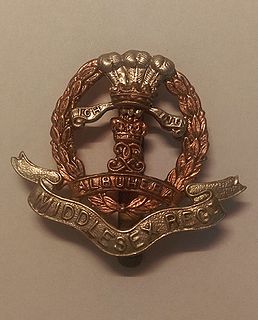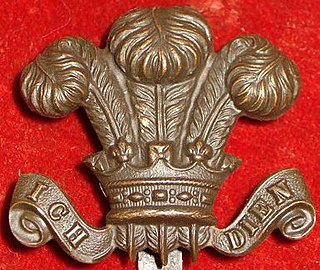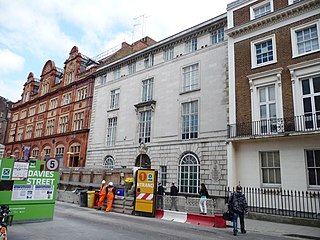
The King's Royal Rifle Corps was an infantry rifle regiment of the British Army that was originally raised in British North America as the Royal American Regiment during the phase of the Seven Years' War in North America known as 'The French and Indian War.' Subsequently numbered the 60th Regiment of Foot, the regiment served for more than 200 years throughout the British Empire. In 1958, the regiment joined the Oxfordshire and Buckinghamshire Light Infantry and the Rifle Brigade in the Green Jackets Brigade and in 1966 the three regiments were formally amalgamated to become the Royal Green Jackets. The KRRC became the 2nd Battalion, Royal Green Jackets. On the disbandment of the 1st Battalion, Royal Green Jackets in 1992, the RGJ's KRRC battalion was redesignated as the 1st Battalion, Royal Green Jackets, eventually becoming 2nd Battalion, The Rifles in 2007.

The Artists Rifles is a regiment of the British Army Reserve. Raised in London in 1859 as a volunteer light infantry unit, the regiment saw active service during the Second Boer War and the First World War, earning a number of battle honours. It did not serve outside Britain during the Second World War, as it was used as an officer training unit at that time. The regiment was disbanded in 1945, but in 1947 it was re-established to resurrect the Special Air Service Regiment. Today, the full title of the Regiment is 21 Special Air Service Regiment (Artists) (Reserve) and with 23 Special Air Service Regiment (Reserve), it forms the Special Air Service (Reserve).

The Post Office Rifles was a unit of the British Army, first formed in 1868 from volunteers as part of the Volunteer Force, which later became the Territorial Force. The unit evolved several times until 1921, after which the name was lost during one of many reorganisations.

The Queen's Westminsters were an infantry regiment of the Territorial Army, part of the British Army. Originally formed from Rifle Volunteer Corps, which were established after a French invasion scare of 1859. The unit became part of the newly established London Regiment on the formation of the Territorial Force in 1908. It was subsequently amalgamated in 1921 with the Civil Service Rifles, and became a territorial Battalion of the King's Royal Rifle Corps in 1937. It ceased to exist as separate entity after it was amalgamated in 1961.

The Middlesex Regiment was a line infantry regiment of the British Army in existence from 1881 until 1966. The regiment was formed, as the Duke of Cambridge's Own , in 1881 as part of the Childers Reforms when the 57th and 77th Regiments of Foot were amalgamated with the county's militia and rifle volunteer units.

The Cambridgeshire Regiment was an infantry regiment of the British Army, and was part of the Territorial Army. Originating in units of rifle volunteers formed in 1860, the regiment served in the Second Anglo-Boer War and the First and Second World Wars before losing its separate identity in 1961. Its lineage is continued today by the Royal Anglian Regiment.
When a World War I medal was issued to a member of Commonwealth forces, it was issued with a Service Number, Rank, Name and Regiment. This information should be on every medal that was issued during the First World War.

The Prince of Wales' Own Civil Service Rifles was an infantry regiment of the Volunteer Force and Territorial Force of the British Army from 1798 to 1921; it saw active service in the Boer War and World War I as part of the London Regiment.
The Kensington Regiment is a unit of the British Army, which originated in the Volunteer Rifle Corps' movement of the 1850s. In 1908 it became a battalion of the London Regiment in the Territorial Force. It was an infantry regiment from 1908-1940, a heavy fire support unit from 1940-1945, and has been a unit of the Royal Corps of Signals since 1945.
The Paddington Rifles was a unit of the Territorial Army.

25th Cyclist Battalion was a bicycle battalion of the London Regiment of the British Army. The battalion was disbanded in 1922.

The Rangers was a volunteer unit of the British Army, originally formed in 1860. It provided a detachment for service in the Second Boer War, saw intensive action on the Western Front in the First World War, and served as motorised infantry during the Second World War during the campaigns in Greece and the Western Desert.
The 1881 Birthday Honours were appointments by Queen Victoria to various orders and honours to reward and highlight good works by citizens of the British Empire. The appointments were made to celebrate the official birthday of the Queen, and were published in The London Gazette on 24 May 1881.
The St Giles's and St George's Bloomsbury Rifle Volunteer Corps, more familiarly known as the Bloomsbury Rifles, was a Volunteer unit of the British Army in London from 1803 to 1814 and from 1860 until 1908.

The Davies Street drill hall is a former military installation in Davies Street, London.
1st Battalion, London Regiment was an infantry battalion in the British Army.
2nd Battalion, London Regiment was an infantry battalion of the British Army.
This page is based on this
Wikipedia article Text is available under the
CC BY-SA 4.0 license; additional terms may apply.
Images, videos and audio are available under their respective licenses.










